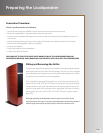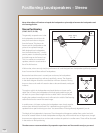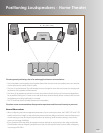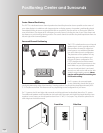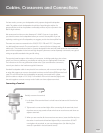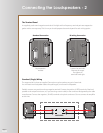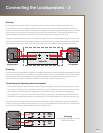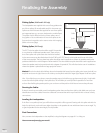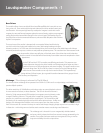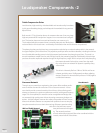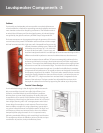
Page 13
Final Adjustments
The Palladium Series loudspeakers have a phenomenal frequency response and superb dynamics, so playing
large orchestral or rock music will be an awesome experience, but may not necessarily be the best guide in
setting up the speakers. Your listening tests should be performed with a wide range of music, including unac-
companied vocal and solo instrumental recordings with as little processing on the source as possible. A natural
solo cello recording will reveal much about the bass characteristics of your room and positioning. The best
position will yield smooth, extended bass without boom or smear.
Stridency in the upper section caused by underdamped rooms can be compensated for by hanging drapes or
pictures on the walls to dampen reverberant walls; increasing the amount of soft furnishings will also help to
eliminate high frequency “ringing”.
Room resonances are often structural. In such circumstances, good placement will minimize but not eliminate
these resonances.
Apparent height is critical. The speakers have controlled directivity. Phase response anomalies are kept to
vanishingly low levels by reducing the distance between the midrange and tweeter horns to the absolute
minimum; nevertheless, if you are in the wrong seat, it may happen that the sound stage is not perfectly inte-
grated. One remedy is to tilt the speaker slightly (if necessary by using a combination of long and short spikes)
to aim the midrange driver at the listener’s ear to yield best driver integration. Take your time with this —the
eects on some music may be small and quite startling on others.
Phase
Phase is not a matter of preference. Out-of-phase eects manifest themselves as poorly dened bass, poor
stereo with very vague localization of instruments and voice, and generally fuzzy, ill-dened sound. A single-
wired out of phase system is easy to detect; a bi-amped system with one element connected out of phase
can be nearly impossible to track down. If you nd that there are problems with the system that no amount of
experimentation can cure, check all the loudspeaker and amplier wiring carefully. If you have connected your
speakers strictly in accordance with this manual, no phase problems will arise.
Conclusion
All the advice above will help you get the most out of these superb loudspeakers, but in the nal analysis you
should do what your ears tell you is right—you are, after all, the nal arbiter of your system.
Happy listening!



